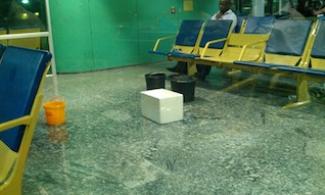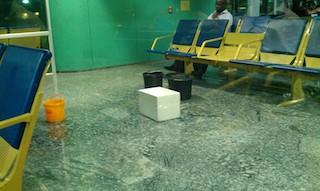
I am not exactly a technophobe but my recent experience at the MMIA, in November 2013, has spurred me to write my first blog. A great deal has been said about the eyesore that MMIA has become and still is. Several writers have succinctly detailed the embarrassment the busiest first port of entry to our shores has become.

I am not exactly a technophobe but my recent experience at the MMIA, in November 2013, has spurred me to write my first blog. A great deal has been said about the eyesore that MMIA has become and still is. Several writers have succinctly detailed the embarrassment the busiest first port of entry to our shores has become.
The announcement of the remodelling was indeed a most welcome piece of news; albeit a cautious one given the way projects are executed in Nigeria.
A lot has been promised about the result of the remodelling; the Minister of Aviation, Ms Stella Oduah, in her ‘on-the-spot-assessment’ of 24 December 2013 said: ‘We want to be able to start the usage of all these facilities by the first quarter of next year. What is very key is that passengers’ travelling experiences will be very, very different. It will be the way it should be; it means you have the comfort, you have the safety and you have the security and most importantly as you’ve seen, we’ve increased the capacity which means you have ample space to really do what you are supposed to do, as a passenger.’
News reports also quoted spokesman of the Federal Airports Authority of Nigeria, Yakubu Dati explaining that the expanded infrastructure will be equipped with 11 toilet facilities for both male and female passengers, as well as disabled persons.
He said the new extension comes with commercial offerings including shops and other business, adding that the duty free shops would provide passengers the opportunity for last minute shopping, refreshments and other conveniences in line with global standards and recommended practices.’
Given that the project’s scheduled completion is imminent, I’ll turn to sharing my on-the spot assessment, particularly the experience at departure Gate E63 whilst waiting for my BA flight.
The assessment will largely be related to some of the key words used by the Minister and the FAAN spokesman i.e. safety, disabled persons, global standards and recommended practices. Before further ado, let me declare that I’m a UK trained and based architect with considerable experience in designing and delivering complex projects. This experience, in my humble opinion, should lend some credence to the following assessment.
After being literally fried due to the lack of air conditioning and passing through the umpteen checks, I was relieved to finally sit down at the departure gate’s unappealing and choked waiting area with my travel companions. No sooner had we sat down when we noticed a most shocking sight; the infamous leaks!
This was the straw that broke the camel’s back! Out came my travel sketchbook and camera to commence the assessment of which I’ll share with you!
Safety –
The first issue that caught my attention was the lack of warning signs to highlight the wet floors. The smooth and shiny floor which appears to have a high slip potential ought to have been cleaned frequently to avoid any slip induced injuries.
The second issue is that of fire safety. The global standard for a public facility is to have illuminated or photo-luminescent directional emergency lighting signage i.e. signage that glows in the dark. The signage at departure gate E63 was not photoluminescent and didn’t conform to global standards in terms of visibility and type; it was painted on the wall and not readily visible in case of an emergency. Generally, signs should incorporate a pictogram, an arrow and possibly words;. A sign with just an arrow, or just words, or an arrow and words, is not deemed sufficient.
The signage pictured above provides direction to a means of escape staircase to be used in the event of fire. The widely accepted criteria for means of escape in the event of a fire are: they should be safe and free from potential hazards; they should discharge persons to a place of safety
The means of escape at E63 failed on both counts. The staircore did not appear to be a protected staircore i.e. the glass wall separating the staircase from the seating area did not appear to be fire-resisting; there was no visible kitemark on the glass to indicate any fire rating.
The essence of having fire-resisting construction is to ensure that the means of escape is not rendered unusable in the event of a fire by the flames and most crucially, smoke, which is responsible for most of the fatalities in a fire. Protected staircores are also meant to be sterile i.e. free from potential ignition
sources. Fire Exit Sign At Newly Remodeled MMIA
Fire Exit Sign At Newly Remodeled MMIA
A visit to the toilet via the staircore was unbelievable; the stair landing area had become a dumping ground for the replaced floor finishes and doors (see images 06 & 07 above). Apart from being unsightly, the carpets especially constitute a fire hazard as they can be easily ignited and cause the means of escape to be unusable.
 Standard Fire Exit Sign
Standard Fire Exit Sign
Just as I thought I wouldn’t unearth any further issues, a look at the fire exit door put me in massive shock; the door was padlocked! How do people escape in an emergency?! The norm is to have a push bar on the exit door to allow escape. To address security concerns, the doors are typically linked to the security alarm and fire detection system to discourage abuse. Apart from being padlocked (see image 08), it leads to the aircraft boarding gate station; surely this cannot be a place of safety for people escaping in the event of an emergency.
The third issue on safety is the lack of disabled refuge points. Disabled refuge points are designated places of safety, usually within protected stair-cores, where wheelchair bound users can stay in the event of an emergency and call for help via an intercom system.
Accessible design –

Fire exit door firmly padlocked at MMIA Heap of trash and fire hazard
Heap of trash and fire hazard
In a public building such as MMIA, it is essential the design caters for disabled users. I
In using the facility, disabled people should not be subject to any indignity, segregation and undue effort. Two incidents that couldn’t be captured on camera to preserve the dignity of those concerned highlight how inaccessible the airport is. The first was where a wheelchair bound lady had problems negotiating the gap in the floor tiles on her way to the departure security gate. The second was where a frail elderly man on a wheelchair had to disembark on the upper level of the E wing and negotiate the stairs to the lower arrivals area aided by his walking stick; this was due to the stair lift being non-operational.
Furthermore, within E63, the toilet provision is only accessible by stairs; what happens when a wheelchair bound user requires the toilet facilities? There ought to be lifts to the lower levels or accessible toilets provided at the upper levels.
The circulation space either side of the rows of seats in E63 were also inadequate for wheelchair bound users and pram users to easily negotiate.
Global Standards – The reasons an international airport needs to adopt internationally
recognizable standards are quite obvious. After all the hard work of my ‘on-the-spot-assessment’, I paid a visit to the restroom and more interesting issues were unravelled. The symbols used to denote the restrooms were unconventional; it took me sometime, when hard-pressed, to decipher which was the male toilet (see image 10)! Why aren’t we using internationally recognizable symbols.
After successfully figuring out the right restroom, more issues were discovered! The space standard was inadequate; one of the toilet cubicles was difficult to access due to an oversized wash hand basin being too close and blocking most of the doorway.
It is also worth noting that there was no clear signage for restrooms that included baby changing facilities – you’ll expect such provision in an international airport. After relieving myself, I decided it was time to draw my impromptu ‘on-the-spot-assessment’ to a close and ponder my findings. This I did in the plane and when I stepped into Heathrow’s Terminal 5, which in stark contrast is many light years ahead, the resolve to make public my findings was sealed.
With the scheduled opening of the remodelling looming, it is pertinent to assess my findings with the benchmark the Minister set at her ‘on-the-spot-assessment’ of 24 December 2013; ‘‘We want to be able to start the usage of all these facilities by the first quarter of next year. What is very key is that passengers traveling experiences will be very, very different. It will be the way it should be; it means you have the comfort, you have the safety and you have the security and most importantly as you’ve seen, we’ve increased the capacity which means you have ample space to really do what you are supposed to do, as a passenger.’ Toilet sign at MMIA
Toilet sign at MMIA
 Global toilet signage
Global toilet signage
In light of my assessment at departure gate E63, the airport still has a long way to go to achieve global standards with respect to being ‘the way it should be’. Comfort, safety, security and space standards are below global standards. Base of wash hand basin blocking entrance to toilet
Base of wash hand basin blocking entrance to toilet
Prior to publishing my blog, I made futile contact with the FAAN to ascertain who the consultants responsible for the remodelling are. I was interested to: a) find out if there were particular standards unknown to me that justified the inadequacies picked up and; b) understand the scope
of their appointment.
I therefore invite a response from the appropriate quarters to the foregoing.
-Architect Balogun is a UK based architect